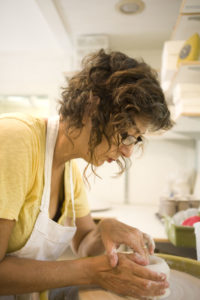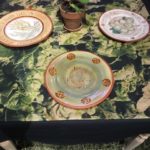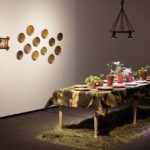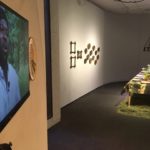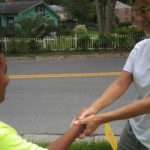Faculty Highlight: Holly Hanessian
Professor Holly Hanessian
Department of Art
Interview by Victoria Salgado
How did you begin making art, specifically ceramics? What were the formative experiences that helped you develop those art practices?
It’s interesting working in a department that’s interdisciplinary. UF that has a very media-specific program, I would probably be exploring a very different path, but I do believe that the concept should drive the art work that you make. I always involved ceramics as my main material because of my passion and because ideas are compelling and create the choice of materials. In the Touch in Real Time project, the clay was integral in terms of the imprint. The final presentation was an artifact—because clay lasts forever, it was a great material fit. In my newest project, The New Histories: The Gadsden Farm, commemorative plates have been made as an idea, like a souvenir plate. I researched commemorative plates made in the South for families and different important life events. I used the visual information to imbue these plates with a commemorative visual power from the South, using red earth and clay. Images of barbwire signaled livestock, but also as a way to capture an image as to what agricultural product they raised. My work has a lot to do with social justice now and it’s driving a bigger idea about inequity and different aspects of our culture.
In that newest project, I went into Gadsden County. It’s the poorest county in the state, an African-American majority county and agricultural county. My collaborative partner, Michael Diaz, and I worked with 12 farmers and involved the state of Florida folklorist and the Florida photographer. We interviewed the 12 people who talked about the issues that they faced over time. The county they live in used to have more millionaires than any other place in the state, and was one of the wealthiest counties and only African-American dominated populations. It’s been really complicated for the minority farmers there. We made a plate in honor of each person that we interviewed. Then, I gave them a piece of sweet potato pie on a sweet potato pie plate to ask them if they would want to participate. We held a dinner in downtown Quincy, and they all got together. The State of Florida archived all their stories through video, which is on the Southern Foodways Alliance oral History website.
Why clay and ceramic processes and no other materials?
It is one of the few materials that your fingers touched directly.
Was that your main motivation for using this material?
It was never my main motivation, it was just the thing I felt compelled to do. I remember when I was an undergraduate and I was first doing it, I said, “Wow, I could go back two thousand years. And I know how to do this really well.”
I’m never happier than when I’m actually physically manipulating clay. Oftentimes, I don’t get that opportunity because my work is so planful. The time I actually spend manipulating clay is minuscule to how much all the other time I life I usually work administratively.
You spoke about how much all the planning and administrative work takes up the majority of your time. But when you do get in the studio, how do you work and get into “the zone”?
I wear so many different hats in life, but the best way for me to really create is to go into a silo of time. If I know I’m going to have a three-day weekend or a longer period of time, I can go into my studio with the idea that I’m going to get a certain amount done during that period of time. Clay demands constant attention. It’s like cooking a meal, you can’t leave it; once you start it, then you have to keep the clay moving along. It’s something you have to hit at the right time or it’ll be ten times more work. So, silos really help me. I do one thing all in, which is hard in contemporary life because you’re supposed to post on Instagram every week to keep your rhythms high. [laughs] Instagram is so visually based that if you want people to respond to you visually, you have to stay in front of their eyes. It’s like a compulsion. And I don’t want to feel like that that’s where my attention goes.
What would you say is at the heart of your work?
It varies a lot project to project, but I do think there are a couple of main elements that always arise. One is the idea of connecting to people, whether it’s socially engaged work, shaking hands with clay in my palm, or making digital work that’s about the lack of touch. All those things go back to being connected to one another and pointing to a community of like-minded people who feel similarly. Community-based, socially engaged works are really important to me.
You worked on your 2012 project, Touch in Real Time, in numerous cities. What was the most challenging part of that endeavor? What was the least challenging?
The most challenging part was the level of emotional endurance. To be completely present to different people over and over and over again over the course of time is hard. Then, I started having people hold hands with each other instead of me doing it. People are interesting. I think of people like cats or dogs and cats are not going to come right up and do something. They’re going to watch and be on the outside fringes. If they feel safe or like it’s good for them, then they’ll come up. Other people are just going to do it. The physical space I was in often determined how comfortable someone was with coming up to me—I had to try not to impose or go up to them because I wanted that openness. Some people have very emotional responses. One person sweated a lot and he really wanted to participate, but he was uncomfortable holding my hand with a sweaty palm. I worked with a neuroscientist in monitoring the brain while touching clay. There were a lot of different permutations of that project. The least challenging part was actually making the work—making balls of clay, then firing them. [laughs]
What was your experience like, collaborating with someone from the neurology field?
That was extremely interesting. The digitally-based work is informed by what is taking place in the brain and then working with a neuroscientist was really interesting. Our mutual interests were at times unequal. He had very little time to work with me. It would be interesting to work with other scientists where the pairing would be more aligned in terms of project goals. My current project (Gadsden Farm project) has 20 collaborators with the 12 farmers. Most of the work is with my main collaborator, Michael Diaz, who’s a designer. Then along with the state of Florida folklorist, the state of Florida photographer, and all the people who connected me to the farmers, ends up being about 30 people involved in this project. That’s complicated! When you collaborate with somebody, you need to appreciate their level of time so that’s why I gave them a pie plate and a piece of pie. I always feel like there needs to be an exchange.
When a new people come on the Board of (National Council on Education and Ceramic Arts, NCECA), I give them a representation of these handshakes because it expressed this dance back and forth that we do. The exchange is lateral and not top down. Even teaching, I feel, is a dance back and forth. It’s not me instructing you and you working in this “over there” capacity. The exchange of ideas needs to be valued. The other thing about teaching is that it should be non-hierarchical. The power shouldn’t all be placed in the hands of the professor; there should be a shared power in terms of how you work in a studio, say.
How do you navigate those disconnects between multiple collaborators?
That’s tricky because it’s a situation where a white privileged person is going into the poorest county and working with people whose lives have been made difficult by people who are white and privileged. Who am I to go into their community and hold them up as a mirror to the larger culture? I feel like there needs to be a level of questioning of, “Who’s getting what from who, and why?” Then, like any good relationship, there has to be clarity and a negotiation of needs that are being met. If I had gone into this group and said, “I want to have an exhibition and use your interview,” that would not have been fair. At the end of the day, they need to have something that’s really important to them and they don’t care about art. They care about giving their lives to farming and what they have at the end of it. So, by them telling their stories, they keep their stories alive amongst their families. Then, they got a commemorative plate, which I think they felt good about. The farmers that did come to the exhibition were so grateful that a light had shined on them in a very positive way. But collaborations don’t always work so well because sometimes you misinterpret or misread, with the best intentions, what something and someone is about. I think you have to be aware that you could face a lot of failure. There needs to be a level of perseverance throughout because you can’t assume it’s going to work out the way you thought it would. You may have to change a lot.
How do you imagine the concepts for projects like these?
I plan ahead intensively. The year that I worked on the Touch in Real Time project, I had a sabbatical, I had one semester. I was busier when I was on my sabbatical than I was not. I went to many places in pop-up shows across the country. The logistics of creating that was intense, creating the travel plans, who would host me, who would pay for what, what I was responsible for, what I was going to do when I was there. I think it’s just the sheer figuring things out that take as much time as any of the actual making or doing. The concept does change over time and gets better. I was got pretty good about picking organizations, since it didn’t cost them anything for me to do this and was an add on. I leveraged high-end organizations in the ceramics community and then could go to another place and let them know where I had just gone. So, the other high-end organization would say, “Oh, well I’m on.” Once you have a couple of them, other places are willing to do that. The whole thing was about being strategic in how to use what had happened.
In the same vein of social justice work, what sparked your interest in bringing The Canary Project to life?
It was a summer when the news was so upsetting. There were so many shootings; it was the explosion of #BlackLivesMatter. It was so frustrating. I felt like life was just boiling over. Two houses down from me is an African-American church that had a summer program. I thought it would be great to have a relationship between these two communities. Again, we’re giving and not taking, but there is an exchange of something. I didn’t know if their summer campers had options to work in clay, so I literally just walked from my studio down there with stuff and asked if they wanted their kids to work on a project about what hope means to them and then they would at the end leave the pieces for others to pick up at the end at Cascades park. The church was happy with the project.
Would you consider yourself a perfectionist in terms of your art?
Yes.
How do you kind of navigate your own critical eye and audience expectations?
The last show, which have these plates, sound files, video, and all these different things… I wanted the audience—three different groups to appreciate it from their perspectives, the farmers, people who work with ceramics- crafts, and people who understand contemporary art. From the farmers’ perspective, they had to feel honored and represented in a truthful way. They had to see enough information that made sense to them as a farmer. From the craft perspective, they had to look at the materials and think it was well done. From a contemporary art perspective, they had to look at the whole thing and see a contemporary context that seemed worthy of having a project like this exist.
What is your most important artistic tool?
My fingers, my hands. Definitely.
What would you say is your daily routine in the studio?
Never the same. [laughs] My dream routine is I would get up and write for an hour. Or read cultural information, just to put my brain in that world. And then I would take a break, walk, eat, change the pace of my day and then I would come to my studio for three hours. Then, in the afternoon I would do a series of organizing. It would be the breakup. But if I could have an hour of thinking and writing and then three hours in the studio of just using that thinking time, putting it back into the work. Today, for example, I spent all morning getting ready for a conversation with my collaborative partner about what we were going to do. And then I have a family, so I have family obligations.
Would you say your inspiration comes randomly or do you have to get into a certain mindset?
Both. It takes me time to process. Both my collaborative partner and I couldn’t believe we hadn’t thought of just buying a huge amount of sweet potatoes to put in the next Gadsden show—how to grow sweet potatoes, how to make sweet potato pie, sweet potato pie plates. Farmers here grow sweet potatoes. I mean, duh, I could just go to Costco and buy a load of sweet potatoes. I don’t need to make all these seed bombs.
Is there a piece of art, exhibition, or publication yeah that you’re most proud of?
An article that I wrote got placed in this anthology called The Ceramics Reader. It was published in Britain last year and it’s about the best of ceramics throughout time. It’s my outlook on digital ceramics. I was pretty proud to be included with the list of other people in there. I’m also proud to be the president of NCECA.
How do you navigate or negotiate the use of physical and digital ceramics?
In terms of the options that are available now, I think of digital ceramics like another tool to help us make art. I don’t think of it as digital versus analog.
Tell us about your work with NCECA.
NCECA is a six-thousand-member ceramic organization that includes students, faculty, curators, gallerists, makers, everybody. It’s one of the biggest art organizations in nine states. It usually has four days of programming and mounts several hundred exhibitions where it takes place. Every year, we have anywhere from seven to eleven students go. We recruit there.
It’s a very exciting conference for people. You can see really cutting edge, contemporary work, but you can also buy mugs. There are a lot of makers. I’m working really hard on diversity and inclusion and really trying to bring up the next level of makers. To me, it’s super important for our culture to embrace because ceramics has always been lower price. Even when people make conceptual ceramic pieces, they haven’t been able to price it the same as sculpture—because it is an equitable and democratic material. All in all, this conference is a great platform for bringing people into the world of ceramics.
How did you end up at FSU?
I had a tenured teaching job in Michigan but it wasn’t a good fit for my family. We wanted to be in a more diverse and culturally immersive environment. I also wanted to be in a research institution. Also, you know, there’s only so many jobs you apply for and only so many places that want you. There are very few teaching jobs available. And I’m from Florida. I actually went to FSU briefly and graduated from UF.
How would you describe your teaching practices?
I think that’s changed over time. I really want students to think and engage with the materials instead of prescribing what they should do from my prospective. I give them projects that I hope help them learn both new techniques, that are conceptually-driven and research-driven. My advanced class, on Wednesday they’ll have a reading due. They have proposals where they do their own research, drawings, and a lot of testing. In the materially-driven process of ceramics, you have to do a lot of testing. They make the work and decide how they are going to present it. I don’t believe that all ceramic objects end on a pedestal. The work needs to be thoughtfully places in a contextual environment. Where, what, and how should the work end up is as important as why you’re making it work and how the audience will see it.
As a professor and artist, what is the most vital idea or lesson you want to instill in students?
To be successful, you have to be passionate, think deeply and you have to persevere.
